Selecting the suitable yarn is pivotal in embroidery, as it profoundly influences the outcome of the stitched creation. The choice of yarn impacts the embroidered piece’s texture, appearance, and overall feel.
From the traditional elegance of cotton and the luxurious sheen of silk to the warmth of wool, each yarn type brings distinct qualities to the crafting table.
This decision involves considering factors such as the embroidery technique, fiber content, texture, and compatibility with the base fabric.
Whether creating intricate details or bold textures, understanding what yarn to use for embroidery is a journey of artistic exploration, personal preference, and aligning the chosen yarn with the envisioned masterpiece.

What Yarn to Use for Embroidery?
When it comes to embroidery, choosing the suitable yarn or thread is essential to achieving the desired results.
One of the most popular and widely used thread types for hand embroidery is stranded cotton, also known as embroidery floss.
Here are the details about what are the best types of yarn for embroidery:
Stranded Cotton/Embroidery Floss
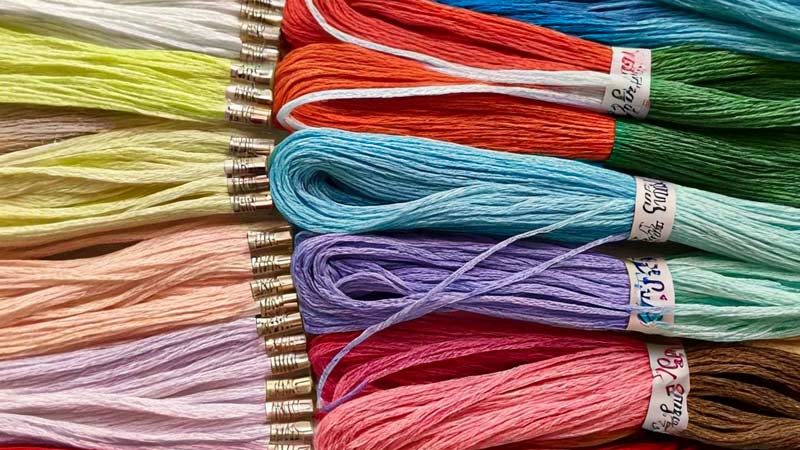
Stranded cotton, also referred to as embroidery floss, stands out as the workhorse of hand embroidery. Comprising mercerized cotton, it is conveniently packaged in skeins.
The main thread can be dissected into six fine strands, each of smaller pieces softly twisted together.
This feature allows for versatility in embroidery techniques, making it suitable for popular styles such as cross-stitch, satin stitch, and backstitch.
The extensive color range in stranded cotton ensures that artists can easily find the perfect shades to bring their creative visions to life.
Perle Cotton
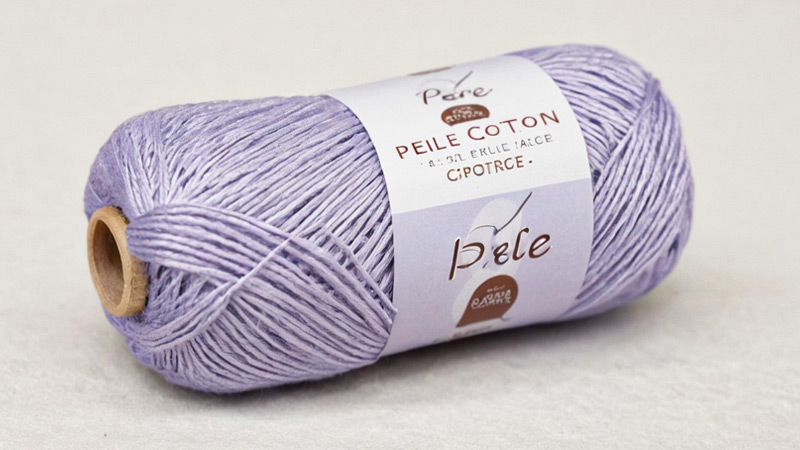
In contrast to the divisible nature of stranded cotton, perle cotton is a non-divisible thread, maintaining a smooth and round structure. Available in various sizes, denoted by numbers; the smaller the number, the thicker the thread.
The slightly glossy finish of perle cotton adds an elegant touch to embroidery work, and its textured appearance makes it a favored choice for artists seeking dimensional effects in their projects.
Crewel Wool
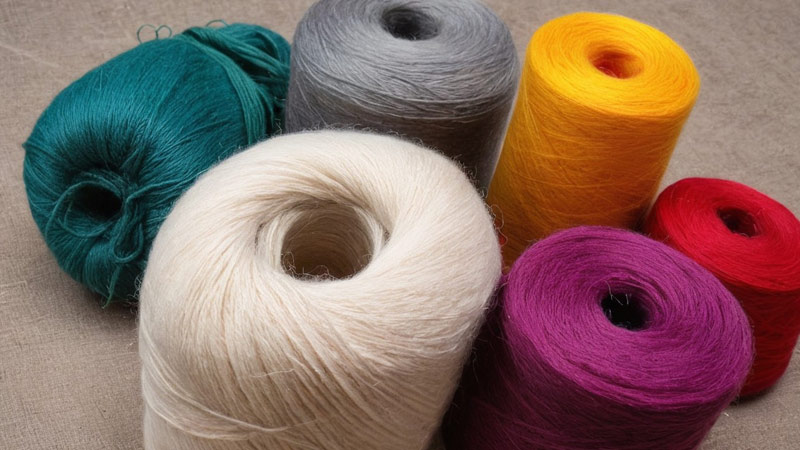
Crewel wool, hailing from fine and soft wool fibers, finds its niche in crewel embroidery. Crewel wool is ideal for surface embroidery, exhibiting a thicker and fluffier texture compared to cotton threads.
Its ability to create a textured, three-dimensional effect adds depth and visual interest to the stitched designs, making it a favorite among those aiming for intricate and layered embroidery work.
Silk Threads
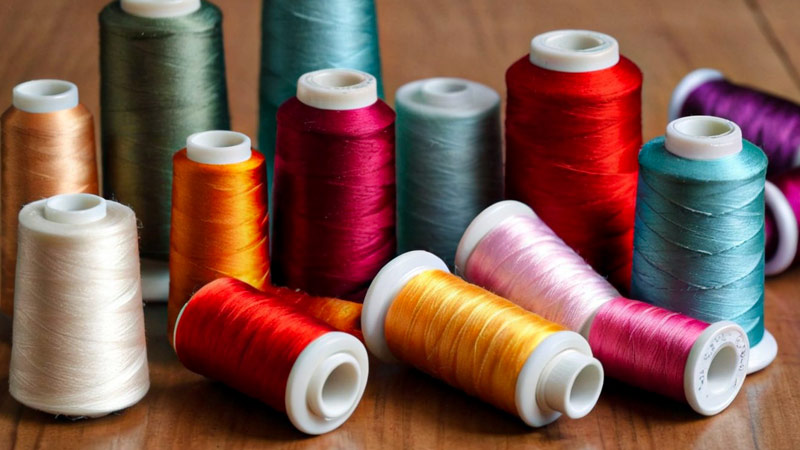
Silk threads introduce a luxurious element to embroidery projects. Renowned for their smooth and shiny finish, silk threads bring an unparalleled elegance to the final piece.
With various types available, including spun silk and filament silk, artists can choose silk threads that align with their artistic preferences and the desired aesthetic for their embroidery work.
Metallic Threads
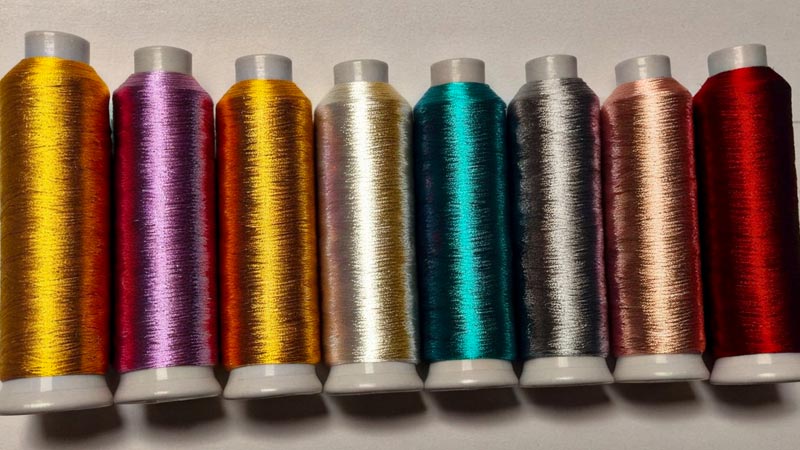
Metallic threads come to the forefront for those seeking a touch of glamour and sparkle in their embroidery.
Infused with metallic elements, these threads add shine and visual interest, making them particularly suitable for decorative stitching.
Metallic threads are often chosen to highlight specific details or to create a captivating contrast in embroidery designs.
Specialty Threads
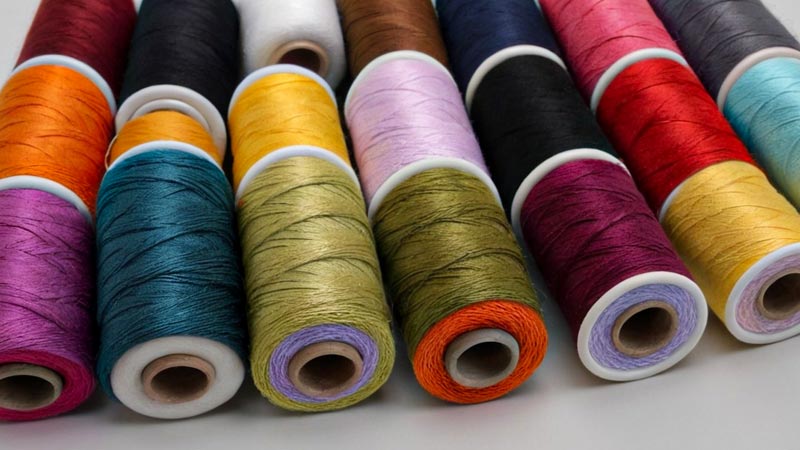
Specialty threads, such as those crafted from rayon, nylon, or unique cotton blends, offer artists an array of options to experiment with textures and effects in their embroidery projects.
These threads contribute to the overall artistic vision by providing specific qualities that enhance the visual and tactile appeal of the stitched designs.
Whether aiming for a matte finish, increased sheen, or a particular texture, specialty threads open avenues for artistic exploration in embroidery.
Advantages of Using Cotton Yarn for Embroidery
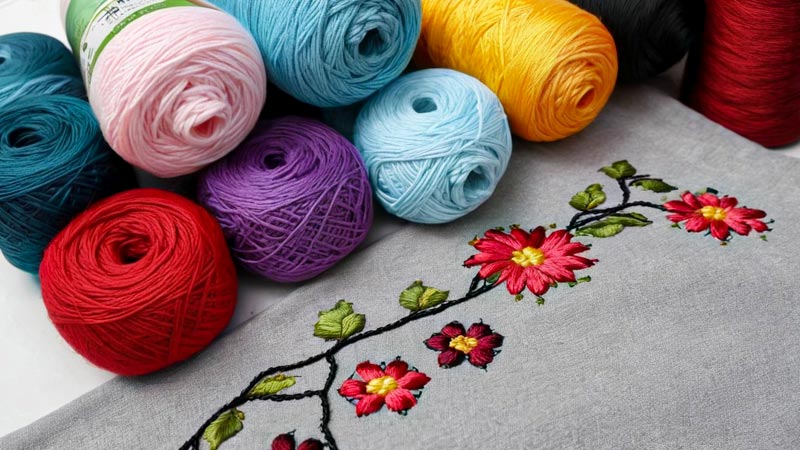
Using cotton yarn for embroidery offers several advantages, making it a popular choice among enthusiasts.
Here are the key advantages of using cotton yarn for embroidery:
Softness and Comfort
Cotton yarn’s reputation for a soft and comfortable feel makes it a top choice in embroidery, especially for projects intended for direct contact with the skin.
The inherent gentleness of cotton ensures that the final stitched piece is visually appealing and offers a delightful tactile experience.
This quality makes cotton yarn ideal for creating garments, baby items like blankets and onesies, and various accessories that require a touch of coziness.
Breathability
The natural fiber composition of cotton allows for excellent air circulation, providing garments with a breathable quality. This breathability is a valuable attribute, particularly for embroidered clothing.
In warm weather, garments made with cotton yarn allow the skin to breathe, reducing the potential for discomfort associated with heat and ensuring that the wearer remains relaxed and comfortable.
Absorbency
Cotton yarn’s remarkable absorbent properties enhance its suitability for embroidery on towels and kitchen linens.
The yarn’s ability to handle moisture effectively ensures that functional embroidered items can showcase intricate designs and fulfill practical purposes.
Whether used in dish towels or bath linens, cotton’s absorbency adds a functional dimension to the beauty of the embroidery.
Versatility
The versatility of cotton yarn is a boon for embroiderers seeking flexibility in their projects. Cotton adapts seamlessly to various embroidery techniques, whether working with fine strands for intricate details or a chunkier yarn to create a bolder texture.
This adaptability allows artists to explore different styles and experiment with textures, making cotton yarn a go-to choice for beginners and experienced embroiderers.
Color Retention
Cotton’s ability to retain color effectively is a crucial advantage in embroidery. When vibrant colors are chosen for a project, cotton ensures that these hues remain vivid over time.
This is especially important after washing or exposure to sunlight, providing longevity to the visual appeal of the embroidered piece.
The enduring vibrancy of colors makes cotton yarn a reliable option for projects where color retention is key.
Washability
Cotton’s ease of care and ability to withstand regular washing makes it a convenient choice for embroidered items that are likely to encounter frequent laundering.
Whether it’s kitchen towels, clothing, or children’s accessories, cotton yarn ensures that the beauty of the embroidery endures through repeated wash cycles.
This characteristic enhances the longevity of the embroidered pieces, making them both visually appealing and durable for everyday use.
Availability and Affordability
The widespread availability of cotton yarn in various colors, thicknesses, and brands is a significant advantage for embroiderers.
Its affordability, especially when compared to some specialty threads, makes cotton a practical and cost-effective choice for individuals at all skill levels.
This accessibility ensures that embroiderers have diverse options at their disposal, making it easy to find the right cotton yarn for their projects.
Additionally, the affordability of cotton yarn allows for budget-friendly replenishment of supplies, supporting continuous creative endeavors.
Compatibility with Various Fabrics
Cotton yarn’s compatibility with a broad spectrum of fabrics, including other cotton, linen, and blends, adds to its appeal.
This versatility empowers embroiderers to choose from diverse base fabrics for their projects without compromising the compatibility of the yarn.
Whether working on a delicate linen canvas or a sturdy cotton garment, the adaptability of cotton yarn ensures that it harmonizes seamlessly with different fabrics, expanding the possibilities for creative expression.
Environmentally Friendly
Cotton’s status as a natural, biodegradable material aligns with environmentally conscious practices. Opting for cotton yarn in embroidery reduces the environmental impact associated with synthetic fibers.
This eco-friendly aspect enhances the appeal of cotton yarn for those who prioritize sustainability in their crafting choices, contributing to a more environmentally responsible approach to textile arts.
Tradition and Heritage
Cotton’s historical significance in embroidery, spanning centuries, adds a layer of tradition and heritage to its appeal.
Its enduring use reflects a connection to cultural and historical practices, making cotton yarn a timeless and classic option for embroiderers who appreciate the richness of handcrafted textiles.
Choosing cotton for embroidery projects allows individuals to partake in a longstanding tradition, infusing their creations with a sense of cultural heritage and timeless elegance.
How to Choose the Right Yarn for Embroidery?
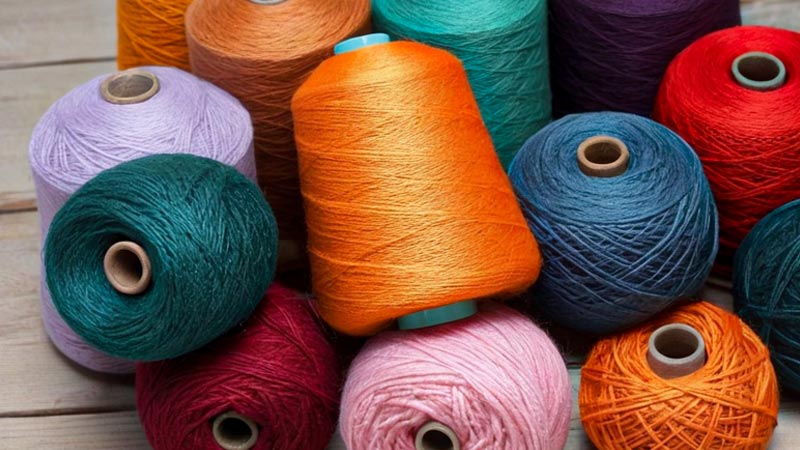
Choosing the suitable yarn for embroidery is a crucial step that can significantly impact the outcome of your project.
Here are vital factors to consider when selecting the perfect yarn for your embroidery:
Type of Embroidery
When considering the type of embroidery, delve into the specific techniques you plan to employ. For instance, stranded cotton or embroidery floss is a staple for cross-stitch and various surface embroidery methods due to its divisible nature.
On the other hand, crewel wool, with its thicker and fluffier texture, finds its preference in crewel embroidery, focusing on intricate designs and textured stitching.
Understanding the requirements of your chosen embroidery style ensures that the yarn you select complements the technique and contributes to the desired visual effects.
Fiber Content
The fiber content of the yarn is a critical factor influencing your embroidery’s overall look and feel. Cotton, a versatile and widely used fiber, is known for its softness and comfort, making it suitable for various projects.
With its luxurious sheen, Silk adds an elegant touch, often chosen for delicate and sophisticated designs. Wool provides warmth and texture, while synthetic blends offer a range of characteristics, such as durability and sheen.
Carefully select the fiber content that aligns with your preferences and the intended aesthetic of your embroidered piece.
Texture and Thickness
Texture and thickness play a significant role in determining the visual impact of your embroidery.
Thicker yarns contribute to bold and textured effects, adding depth to certain embroidery styles. Finer yarns, on the other hand, are ideal for achieving intricate details and delicate stitches.
Understanding the texture you want to convey in your design helps in selecting the appropriate yarn thickness, ensuring that it aligns harmoniously with your creative vision.
Color and Dye Fastness
The color palette you choose can enhance or define the character of your embroidered piece. Vibrant hues or subtle shades can evoke different emotions and atmospheres.
Additionally, considering the dye fastness of the yarn is crucial to ensure that the colors withstand washing and exposure to light over time.
Testing a small sample before embarking on your project allows you to anticipate and address any potential issues related to bleeding or fading, ensuring the longevity of your chosen colors.
Project Purpose
The purpose of your embroidered piece guides your yarn selection, for functional items like kitchen towels or clothing, durability and washability become paramount considerations.
In such cases, opting for yarn that can withstand frequent use and laundering ensures the longevity of the embroidery and the item itself.
Conversely, for decorative pieces, such as framed artwork or specialty crafts, you have more flexibility to explore luxurious or specialty yarns that contribute to the artistic and aesthetic qualities of the finished creation.
Understanding the intended purpose helps align your yarn choice with your project’s practical and visual aspects.
Base Fabric
When choosing yarn for embroidery, it’s essential to consider the fabric on which you’ll be working. Different yarns interact uniquely with specific fabrics, influencing the final appearance and texture of the embroidery.
Cotton yarn, for instance, is renowned for its compatibility with a wide range of fabrics, making it a versatile choice for various projects.
Its smooth and soft texture works well on cotton, linen, and blends. On the other hand, silk yarn may be chosen to complement more delicate materials, adding a touch of elegance to fine fabrics.
Understanding the compatibility between yarn and base fabric ensures a harmonious and visually pleasing result.
Personal Preferences
Your personal preferences play a pivotal role in selecting the suitable yarn for your embroidery project. Consider the feel, sheen, and texture that resonate with your artistic vision.
Some embroiderers prefer the comfort and softness of cotton, while others may be drawn to silk’s luxurious touch and sheen.
Exploring different yarns based on your preferences contributes to a more satisfying creative experience, allowing you to infuse your unique style into the finished piece.
Budget
When choosing yarn for embroidery, being mindful of your budget is a practical consideration. While specialty yarns are available, bare fibers like cotton and wool are generally more budget-friendly.
Balancing quality and cost ensures you can create beautiful embroidery without exceeding your financial constraints.
By exploring cost-effective options, you can embark on projects with the confidence that your yarn choices align with your creative vision and budgetary considerations.
Experimentation
Embarking on an embroidery project provides an excellent opportunity for experimentation with different yarns.
Before committing to a larger project, purchase small quantities of various yarn to test on a sample piece.
This experimentation phase allows you to assess how the yarn interacts with your chosen fabric and embroidery technique.
It also provides valuable insights into the visual and textural effects that different yarns can achieve, empowering you to make informed decisions and refine your creative approach.
Accessibility
Consider the accessibility of the chosen yarn, especially when working on larger projects that may require substantial quantities.
Ensure that the yarn you select is readily available in the quantities you need. This consideration becomes particularly important for ongoing or extensive projects, where consistent access to the same yarn is crucial.
Checking the availability of the yarn ensures a seamless and uninterrupted creative process, allowing you to focus on the artistry of your embroidery without concerns about supply limitations.
FAQs
Can You Use Yarn for Embroidery?
Yes, yarn is commonly used for embroidery, offering versatility with various types like stranded cotton, perle cotton, crewel wool, silk threads, and metallic threads.
What Is the Best Yarn for Sweater Embroidery?
The best yarn for sweater embroidery depends on factors like fabric and design complexity.
Fine yarns like embroidery floss suit intricate designs, while thicker options like crewel wool add texture to more prominent motifs on sweaters.
To Recap
The choice of yarn for embroidery is an artful decision that weaves together creativity, craftsmanship, and practical considerations.
From the soft versatility of cotton to the opulent allure of silk, each yarn type imparts a unique character to the embroidered creation.
Balancing personal preferences, project requirements, and budget constraints ensures a harmonious blend of aesthetics and functionality.
As embroiderers navigate the vast array of yarn options, experimentation becomes a valuable ally in discovering the perfect match for their artistic vision.
In this tapestry of choices, the suitable yarn enhances the visual appeal. It enriches the tactile experience, making every embroidered piece a testament to skill, intention, and the beauty of handcrafted textiles.
Leave a Reply